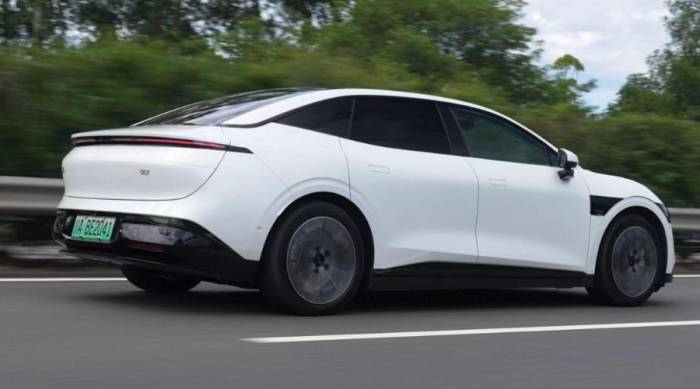Zeekr 007's real 800V charging is fast, but the high-speed cruising range needs
tech | 2024-04-01
The old saying goes, "Thirty years east of the river, thirty years west of the river." Japanese cars were once the mentors of domestic vehicles, but in the era of new energy, self-owned brands have begun to export positively.
A few days ago, the Japanese media conducted a teardown of the Zeekr 007. After the teardown, they said that the Zeekr 007 is the "best value for money" Chinese electric vehicle, and also referred to the Zeekr 007 as a technology-savvy "Geely version of Lexus."
At the same time, the Zeekr 007 is also quite popular in the domestic market, with an average monthly sales volume of about 4,000 units, which is considered a good performance in the 250,000 yuan class pure electric sedan market. So, how much is the energy consumption discount of such a high-heat pure electric sedan on the highway? In this issue of "Extreme Anxiety," we will help everyone measure it.
01
Fast charging, but the range discount is a bit significantFirstly, the Zeekr 007 we rented is the most basic version - the 2024 rear-wheel drive model with a 75kWh battery, with a guide price of 209,900 yuan. The battery uses a lithium iron phosphate battery with a capacity of 75 kWh, and the battery cells are from Quzhou Ze Electric. The official energy consumption is 12.5 kWh per 100 km.
By the way, the average rental price for a Zeekr 007 in Chengdu is currently around 400 yuan per day.
Before setting off, we charged the Zeekr 007 to 96% State of Charge (SOC) and reset the driving mileage, energy consumption, and other information to zero. At the same time, we set the driving mode to normal, the air conditioning to 22 degrees Celsius, the fan speed to two levels, and there were two adult men in the car throughout the journey.
Advertisement
The first observation of the mileage was after driving 100 km on the highway, at which point the average speed reached 105 km/h, with 74% SOC remaining, 22% SOC consumed, and the displayed energy consumption was 18.7 kWh/100 km.
The second observation of the mileage was after completing a full circle on the Second Ring Road in Chengdu, having driven 226.4 km, with an average speed of 107 km/h - the test was conducted mostly at the 120 km/h speed limit - at this point, 44% SOC remained, 52% SOC was consumed, and the high-speed energy consumption discount rate can basically be considered as 63%, with the displayed energy consumption at 18 kWh per 100 km.The high-speed energy consumption of the Zeekr 007 at a 6.3 discount is average among the tested models, mainly because Zeekr has labeled this 75-kWh battery with a CLTC range of 688 km, which is a bit too aggressive.
Fortunately, the Zeekr 007 has a good charging efficiency. With a single 200kW fast-charging pile, the Zeekr 007 can go from 19% SOC to 98% SOC in less than 38 minutes. The charging power can be maintained at around 170kW before 80% SOC, but during the latter trickle-charging phase, the charging power of the Zeekr 007 drops significantly, to about 50kW.
It can be seen that the 800V high-voltage fast-charging platform and 4C battery cells of the Zeekr 007 do indeed significantly improve charging efficiency.
02
It's enjoyable to drive but requires adaptation; the chassis has a German flavor.
The first contact with the Zeekr 007 requires an adaptation process because, although this car is the "base model," it is equipped with a large motor with a maximum power of 310kW and a peak torque of 440N·m, capable of breaking the 100 km/h mark in about 5.6 seconds, so it is quite aggressive in performance. Coupled with the good NVH performance of the Zeekr 007, there may be a certain discomfort when first driving the Zeekr 007.After driving for a few dozen kilometers and getting accustomed to it, you will find that the Zeekr 007 is quite comfortable to drive. In addition to the strong performance of the entire series of models mentioned earlier, the steering setup of the Zeekr 007 is also sportily tuned, with precise directional accuracy and moderate feedback force, not too light, so it gives a slight feeling of a sports sedan.
At the same time, one of the advantages of the Zeekr 007 is its chassis tuning. First, it features a front double wishbone/rear multi-link independent suspension structure. Second, the overall suspension tuning takes into account both comfort and sportiness. When driving in the city over potholes and speed bumps, the jolts transmitted to the body are relatively few, and the overall comfort is well controlled. During cornering, the suspension provides ample support, offering good handling performance.

It is also worth mentioning that many consumers may not be very impressed with Zeekr's intelligent driving performance. In fact, from our high-speed experience, the L2-level driver assistance functions equipped on the Zeekr 007 are quite user-friendly. During high-speed driving, it can handle most use scenarios, such as adaptive cruise control, avoiding large vehicles, etc., which can alleviate driving fatigue to some extent. However, there is still room for improvement in the Zeekr 007's intelligent driving system when dealing with some extreme scenarios and handling details.
03
Driving SummaryIn general, the Zeekr 007 has a considerable performance in the field of three-electric technologies. Although the high-speed energy consumption discount rate is relatively low, it can compensate through its efficient charging efficiency, so there is no need for excessive anxiety about range.
Moreover, the Zeekr 007 stands out in terms of its handling, performance, and satisfactory in-car experience. Therefore, it is quite reasonable for Japanese media to bestow the title of "Geely's Lexus" upon the Zeekr 007.
Comments